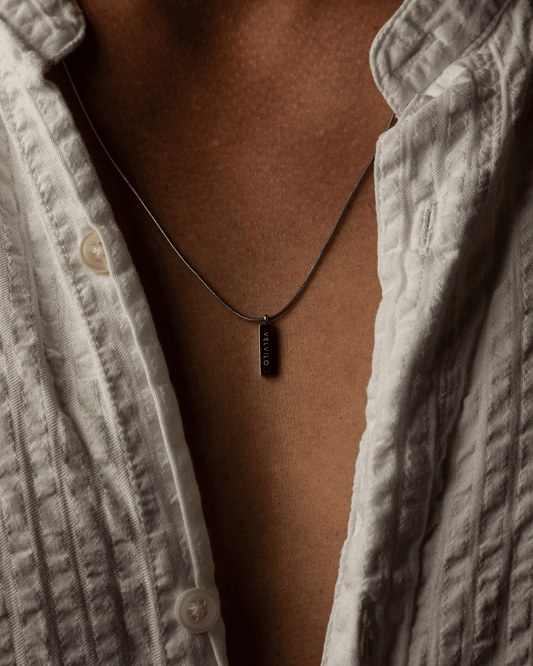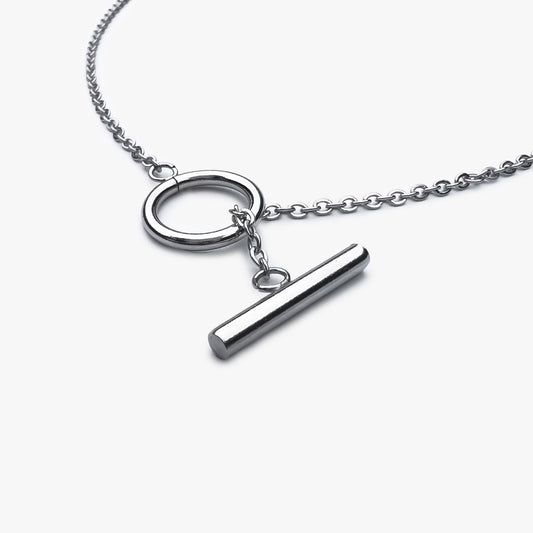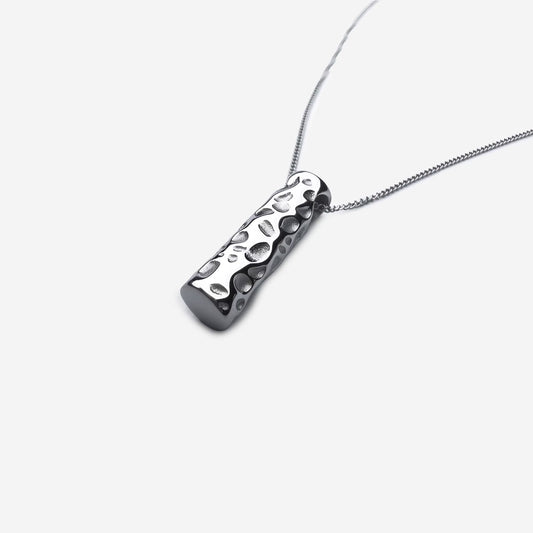Understanding Silver Necklaces
Silver necklaces embody elegance and versatility, making them a cherished item in jewelry collections. Central to their care is understanding silver's nature. Silver, an inherently soft metal, is prone to scratches, tarnish, and bending. Its high reactivity with sulfur compounds in the air leads to tarnishing, a common issue that manifests as a black coating. This characteristic necessitates specific maintenance routines. Additionally, silver necklaces often contain alloys, typically copper, to enhance durability. Recognizing these aspects is crucial in adopting appropriate care techniques, ensuring the longevity and luster of these exquisite pieces, and making them timeless treasures in your personal collection. See more of men’s necklaces in silver here!
Daily Care Tips
Daily care is crucial for maintaining the luster and longevity of your silver necklace. To preserve its beauty, it's important to avoid exposing it to harsh chemicals, such as chlorine and cleaning agents, which can accelerate tarnishing. It's advisable to remove your necklace during activities like swimming, bathing, or heavy physical work to prevent scratches and damage. Regularly wiping the necklace with a soft, lint-free cloth helps remove oils and residue that can contribute to tarnishing. Keeping the necklace away from direct sunlight and heat sources also aids in preserving its color and shine. By incorporating these simple practices into your routine, you can significantly extend the life and appearance of your silver necklace. See more of men’s necklaces!
Storage Solutions for Longevity
Proper storage is essential for preserving the longevity and beauty of your silver necklace. The ideal storage solution is a cool, dry place away from direct sunlight, which can cause tarnishing and discoloration. Using anti-tarnish bags or a jewelry box lined with tarnish-resistant cloth can provide additional protection. It's important to store silver necklaces separately to avoid scratches and entanglements with other jewelry. For those who wear their silver pieces infrequently, sealing them in airtight ziplock bags with anti-tarnish strips can prevent oxidation. Regularly rotating the stored pieces also helps in maintaining their condition, ensuring that each necklace remains a timeless addition to your collection.
Preventing Tarnish and Discoloration
Preventing tarnish and discoloration in silver necklaces involves proactive and regular care. Tarnish, primarily caused by silver’s reaction with sulfur-containing substances in the air, can be minimized by reducing the necklace's exposure to air and humidity. Storing silver in airtight containers with anti-tarnish strips is effective. Avoiding contact with substances like perfumes, lotions, and household cleaners is crucial, as these can accelerate tarnishing. Wearing your silver necklace regularly can also help, as the natural oils in your skin can clean the silver. However, it’s important to clean it with a soft cloth after use to remove any residues. If tarnish does occur, using a silver polish or a homemade cleaning solution like baking soda and water can restore its shine.
How to Take Care of Your Silver Necklace
Taking care of your silver necklace involves both preventive measures and regular maintenance. To prevent tarnish, store it in a dry, cool place, ideally in an airtight container with anti-tarnish strips. Avoid exposing it to chemicals, harsh environments, and extreme temperatures. For daily maintenance, gently wipe your necklace with a soft, lint-free cloth after each wear to remove oils and impurities. Periodically, perform a more thorough clean using a mild soap and water solution, followed by a thorough rinse and dry. For deeper cleaning, specially formulated silver cleaners can be used, but always follow the product instructions carefully. Regularly inspect for any signs of wear or damage and consider professional servicing if necessary. This comprehensive approach will ensure your silver necklace remains a stunning and cherished piece for years to come.
Matching Silver Necklaces with Outfits
Matching silver necklaces with outfits is an art that enhances your overall style. Silver's versatile and reflective nature makes it a perfect complement to a wide range of colors and fabrics. For a classic look, pair a simple silver chain with a black or white outfit, allowing the necklace to stand out. For a more vibrant ensemble, silver can balance brightly colored garments, adding a touch of elegance. Layering different lengths of silver necklaces creates a trendy and dynamic appearance, especially with V-neck tops or dresses. When wearing patterns or detailed clothing, opt for a minimalistic silver pendant to avoid overwhelming the look. Silver necklaces also pair beautifully with formal attire, adding a sophisticated and timeless touch to evening gowns or cocktail dresses.
Frequently asked questions about men’s necklaces
What are the best practices for storing a silver necklace?
Storing a silver necklace properly is key to preserving its beauty and preventing tarnish. The best practice is to keep it in a cool, dry place, away from direct sunlight and moisture, which can accelerate tarnishing. Use anti-tarnish bags or a dedicated jewelry box with a soft lining to protect the necklace from scratches and exposure to air. Individual compartments or hooks are ideal to prevent tangling with other jewelry pieces. For added protection, consider placing anti-tarnish strips or silica gel packets in the storage area to absorb moisture and sulfur compounds in the air. Regularly inspect and gently clean your necklace before storing it, ensuring it's free from oils and dirt that can contribute to tarnishing. This careful approach to storage will help maintain the necklace's luster and longevity.
How often should a silver necklace be cleaned?
The frequency of cleaning a silver necklace depends on how often it's worn and its exposure to tarnishing elements. As a general guideline, a silver necklace should be gently cleaned every one to two months if worn regularly. This routine helps remove surface dirt and body oils that can contribute to tarnishing. However, if you notice signs of tarnish or if the necklace is exposed to harsh environments, more frequent cleaning may be necessary. For those who wear their silver necklace infrequently, cleaning it before and after each use is sufficient to maintain its shine and prevent tarnish buildup. Remember, gentle and regular care is key to preserving the beauty of your silver jewelry.
Can household items be used to clean silver necklaces?
Yes, household items can be effectively used to clean silver necklaces, offering a convenient and budget-friendly alternative to commercial cleaners. Baking soda and water create a gentle paste that can remove tarnish when applied with a soft cloth. White vinegar mixed with water is another option, especially for heavily tarnished pieces. For a quick polish, toothpaste (non-gel and non-abrasive) applied with a soft brush can work wonders. Another popular method involves lining a bowl with aluminum foil, adding hot water and baking soda, and soaking the necklace briefly; this chemical reaction helps remove tarnish. It's crucial, however, to rinse and dry the necklace thoroughly after cleaning with these substances to prevent any residue. While effective, these methods should be used cautiously and sparingly to avoid potential damage to delicate silver jewelry.
What are common mistakes to avoid when caring for a silver necklace?
When caring for a silver necklace, several common mistakes should be avoided to preserve its condition. One key error is exposing the necklace to harsh chemicals found in cleaning agents, chlorine, and cosmetics, which can cause tarnishing and damage. Another mistake is improper storage, such as keeping the necklace in damp or unventilated areas, leading to accelerated tarnishing. Over-cleaning or using abrasive materials can also scratch and wear down the silver. Neglecting regular cleaning and allowing tarnish to build up excessively can make restoration more difficult. Additionally, wearing the necklace during physical activities or in pools can expose it to undue stress and harmful chemicals. By avoiding these pitfalls, you can ensure your silver necklace remains lustrous and durable over time.
How does regular wear affect the durability of a silver necklace?
Regular wear can both positively and negatively affect the durability of a silver necklace. On the one hand, frequent wear helps keep silver polished and lustrous, as the natural oils in your skin can clean the metal. This gentle, ongoing care can reduce the likelihood of tarnish and keep the necklace looking bright. On the other hand, regular wear can expose the necklace to potential hazards. Silver is a relatively soft metal and can be susceptible to scratches, dents, or deformation from daily activities. Exposure to body sweat, cosmetics, and environmental pollutants can also accelerate tarnishing and wear. Hence, while regular wear can maintain the necklace’s sheen, it necessitates a balanced approach with careful handling and regular cleaning to ensure the necklace’s longevity and resilience.
Conclusion of men’s necklaces in silver
In conclusion, men's silver necklaces stand as a testament to both style and resilience. These pieces have transcended time and fashion trends, offering a versatile accessory choice for men. While inherently robust, silver necklaces require careful maintenance to preserve their luster and prevent tarnish. Regular cleaning, proper storage, and mindful wear are key to sustaining their elegance. The adaptability of silver necklaces in complementing a range of styles, from casual to formal, makes them a valuable addition to any wardrobe. Embracing these care practices ensures that men’s silver necklaces remain not just a fashion statement but a lasting symbol of personal style and sophistication.








